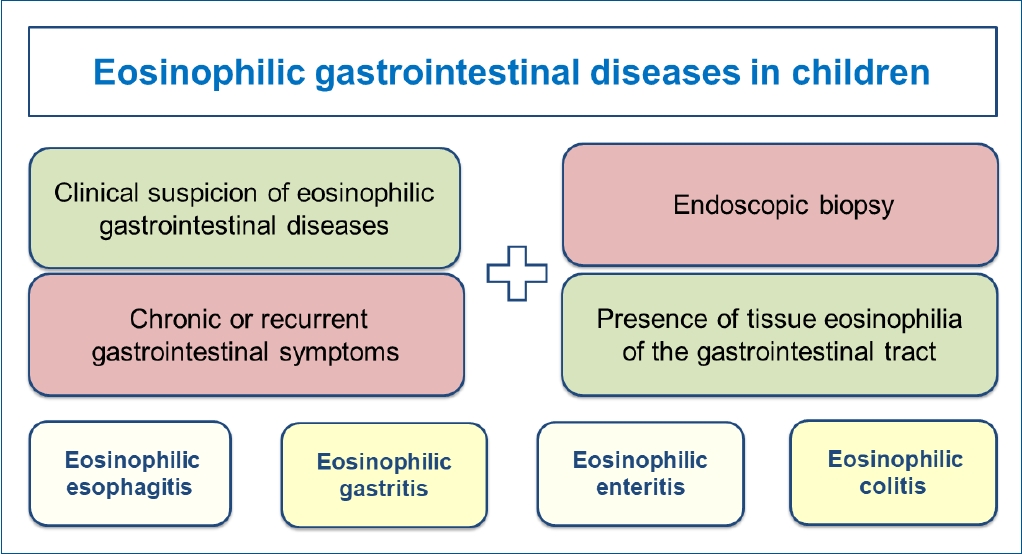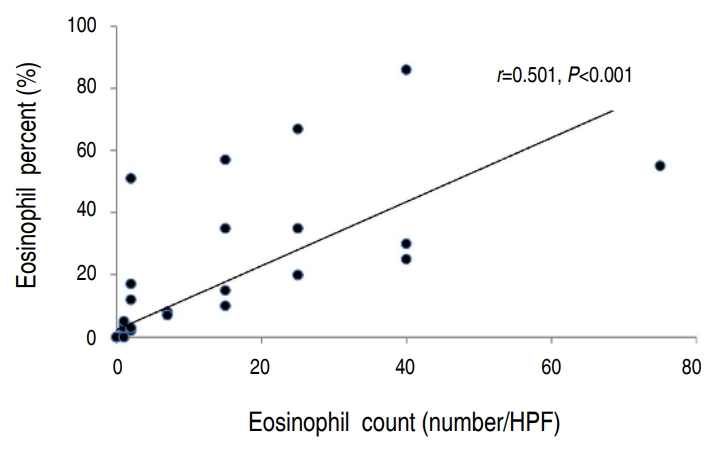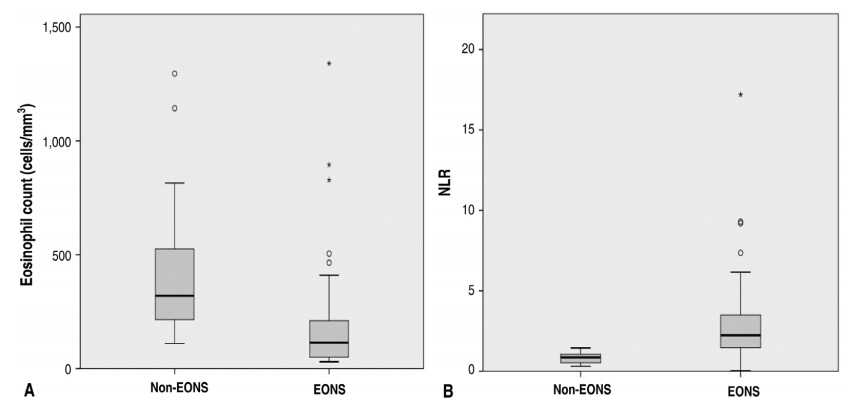Search
- Page Path
-
- HOME
- Search
- Review Article
- Allergy
- Recent topics on gastrointestinal allergic disorders
- Yoshiyuki Yamada
- Clin Exp Pediatr. 2023;66(6):240-249. Published online January 9, 2023
-

Gastrointestinal (GI) allergies are divided into immunoglobulin E (IgE)-mediated, non-IgE-mediated, and mixed types. In addition to non-IgE-mediated, overlapping eosinophilic GI disorders (EGIDs) have increased in Japan. EGIDs, a mixed-type allergy category, include eosinophilic esophagitis (EoE) and non-EoE EGIDs. The number of EoE cases has increased in Western countries, followed by Asian countries. Recent GI allergies may also be associated with type 2 inflammation.
- Gastroenterology
- Update on eosinophilic gastrointestinal disease beyond eosinophilic esophagitis in children
- Hye Ran Yang
- Clin Exp Pediatr. 2023;66(6):233-239. Published online January 3, 2023
-

· Eosinophilic gastrointestinal disease (EGID) is uncommon, with a prevalence of 1–30/100,000 in the general population; however, it is increasing worldwide.
· The diagnosis of EGID is based on histopathological findings of endoscopic mucosal biopsy in which tissue eosinophils are counted in each gastrointestinal tract segment of patients with chronic or recurrent gastrointestinal symptoms.
· Individualized treatment strategies, including adequate dietary and pharmacological therapy, may help improve outcomes of children with EGID.
- Allergy
- Eosinophils and childhood asthma
- Bong Seok Choi
- Clin Exp Pediatr. 2021;64(2):60-67. Published online January 6, 2021
-
•In allergic eosinophilic asthma, eosinophils act as important effector cells and antigen-presenting cells, while in nonallergic eosinophilic asthma, type 2 innate lymphoid cells play an important role in eosinophil activation.
•Sputum eosinophil counts can be helpful for evaluating allergic airway inflammation in asthma.
• Anti-interleukin-5 has broadened the scope of asthma treatment.
- Montelukast use over the past 20 years: monitoring of its effects and safety issues
- Yong Ju Lee, Chang-Keun Kim
- Clin Exp Pediatr. 2020;63(10):376-381. Published online February 5, 2020
-

Although the efficacy of montelukast is inferior to that of ICS, both physicians and parents prefer montelukast to ICSs.
EDN may be a useful biomarker for the treatment and monitoring of preschool children with asthma.
The US FDA requires boxed warning about serious neuropsychiatric events of montelukast, therefore, physicians should consider the benefits and risks of montelukast before prescribing it.
- Original Article
- Allergy
- Nasal eosinophilia and eosinophil peroxidase in children and adolescents with rhinitis
- Yeonu Choi, Haeun Jeon, Eun Ae Yang, Jong-Seo Yoon, Hyun Hee Kim
- Clin Exp Pediatr. 2019;62(9):353-359. Published online April 24, 2019
-

Background: Researchers have shown that eosinophil peroxidase (EPO) is a relatively accurate marker of eosinophilia and eosinophil activity. However, its use as a marker of eosinophilic inflammation in nasal secretions is limited because the diagnostic cutoff values of EPO for use as a one-time test for allergic diseases such as allergic rhinitis have not been established.
Purpose: To identify the correlation...
- Neonatology (Perinatology)
- Diagnostic value of eosinopenia and neutrophil to lymphocyte ratio on early onset neonatal sepsis
- Rocky Wilar
- Clin Exp Pediatr. 2019;62(6):217-223. Published online October 8, 2018
-

Purpose: To determine the diagnostic value of eosinopenia and the neutrophil-to-lymphocyte ratio (NLR) in the diagnosis of early onset neonatal sepsis (EONS). Methods: This cross-sectional study was conducted in the Neonatology Ward of R.D. Kandou General Hospital Manado between July and October 2017. Samples were obtained from all neonates meeting the inclusion criteria for EONS. Data were encoded using logistic regression...
- Case Report
- Nephrology (Genitourinary)
- Eosinophilic gastroenteritis in an 18-year-old male with prolonged nephrotic syndrome
- Da Min Choi, Jung Eun Pyun, Hyung Eun Yim, Kee Hwan Yoo, Jung Ok Shim, Eun Jung Lee, Nam Hee Won
- Clin Exp Pediatr. 2016;59(Suppl 1):S72-S75. Published online November 30, 2016
-
Eosinophilic gastroenteritis is a rare disease characterized by prominent eosinophilic tissue infiltration of the gastrointestinal tract. Here, we report a case of eosinophilic gastroenteritis in an 18-year-old patient with prolonged nephrotic syndrome who presented with abdominal pain and peripheral hypereosinophilia. During the previous 2 years, he had visited local Emergency Department several times because of epigastric pain and nausea. He...
- Original Article
- The relationship between eosinophilia and bronchopulmonary dysplasia in premature infants at less than 34 weeks' gestation
- Joo Yun Yang, Jihei Cha, So-Yeon Shim, Su Jin Cho, Eun Ae Park
- Clin Exp Pediatr. 2014;57(4):171-177. Published online April 30, 2014
-
Purpose Eosinophilia is common in premature infants, and its incidence increases with a shorter gestation period. We investigated the clinical significance of eosinophilia in premature infants born at <34 weeks gestation.
Methods We analyzed the medical records of premature infants born at <34 weeks gestation who were admitted to the neonatal intensive care unit at Ewha Womans University Mokdong Hospital between January 2003...
- Review Article
- Eosinophil-derived neurotoxin: a novel biomarker for diagnosis and monitoring of asthma
- Chang-Keun Kim
- Clin Exp Pediatr. 2013;56(1):8-12. Published online January 29, 2013
-
Asthma is associated with increased levels of eosinophils in tissues, body fluids, and bone marrow. Elevated levels of eosinophil-derived neurotoxin (EDN) and eosinophil cationic protein (ECP) have been noted in asthma patients. Higher levels of EDN and ECP are also associated with exacerbated asthmatic conditions. Thus, EDN, along with ECP, may aid the diagnosis and monitoring of asthma. Several groups...
- Case Report
- A case of cytomegalovirus-negative Ménétrier's disease with eosinophilia in a child
- Keun Hyung Son, Jeong Ja Kwak, Jae Ock Park
- Clin Exp Pediatr. 2012;55(8):293-296. Published online August 23, 2012
-
Ménétrier's disease is a rare form of acquired gastropathy characterized by giant rugal folds in the stomach and protein-losing gastropathy. Children with Ménétrier's disease tend to follow a benign self-limited course with symptoms typically completely resolving within 2 to 10 weeks in contrast to the chronic course in adults. A 9-year-old girl presented with a history of gradually worsening abdominal...
- Original Article
- Analysis on the cause of eosinophilia in a neonatal intensive care unit
- Jeoung Young Kim, Hyo Bin Im, Min Jung Sung, Sang Hee Son, Son Sang Seo
- Clin Exp Pediatr. 2010;53(1):28-32. Published online January 15, 2010
-
Purpose : Although eosinophilia is a common laboratory finding in many neonatal intensive care units (ICUs), its causative mechanisms remain obscure. We aimed to determine the causes of eosinophilia in the neonatal ICU environment. Methods : Serial eosinophil counts were determined weekly for 288 hospitalized, appropriately grown neonates. Infants were divided into four groups according to gestational age, and the... -
- Case Report
- Fatal plastic bronchitis with eosinophilic casts in a previously healthy child
- Young Kuk Cho, Soo Min Oh, Woo-Yeon Choi, Eun Song Song, Dong-Kyun Han, Young-Ok Kim, Jae Sook Ma
- Clin Exp Pediatr. 2009;52(9):1048-1052. Published online September 15, 2009
-
Plastic bronchitis is a rare disease characterized by the recurrent formation of branching mucoid bronchial casts that are large and more cohesive than those that occur in ordinary mucus plugging. Casts may vary in size and can be spontaneously expectorated, but some require bronchoscopy for removal. Plastic bronchitis can therefore present as an acute life-threatening emergency if obstruction of the... -
- Review Article
- Eosinophil disorders
- Sun Young Kim
- Clin Exp Pediatr. 2009;52(6):643-648. Published online June 15, 2009
-
Blood eosinophilia can be classified as either familial or acquired. Familial eosinophilia is a rare autosomal dominant disorder characterized by a stable eosinophil count. Acquired eosinophilia is classified further into a primary or secondary phenomenon depending on whether eosinophils are considered integral to the underlying disease. Primary eosinophilia is considered clonal in the presence of either a cytogenetic abnormality or... -
- Case Report
- Two Cases of Paragonimiasis in Young Siblings Presenting with Pleural Effusion and Subcutaneous Nodules
- Moon Young Jeong, Hee Jo Baek, Duck Cho, Jin Kim, Chan Kyoo Hwang, Dong Kyun Han, Jae Sook Ma, Hoon Kook
- Clin Exp Pediatr. 2005;48(12):1385-1388. Published online December 15, 2005
-
Paragonimiasis is the infestation of lung flukes of the trematode genus Paragonimus. This disease is common in Asia, and the southern part of Korea has been known as one of the endemic areas of Paragonimiasis westermanii in Korea. Human infection is associated with specific dietary habits, such as eating freshwater crawfish or crabs. In a 6 1/2-year-old boy with pleural... -
- Original Article
- Serum ECP, RANTES and Eotaxin Levels in Infants with Bronchiolitis
- Jong Seo Yoon, Mi Hee Lee, Joon Sung Lee
- Clin Exp Pediatr. 2004;47(2):170-176. Published online February 15, 2004
-
Purpose : Viral respiratory infection, especially respiratory syncytial(RS) virus, can predispose sufferers to the development of asthma by mechanisms that are presently undetermined. The role of inflammatory mediators in pathogenesis of asthma and RS virus disease is not well-understood. We investigated the performance of serum eosinophil cationic protein(ECP), regulated on activation normal T-cell expressed and secreted(RANTES) and eotaxin levels on... -
- Peripheral Blood Eosinophil Counts and Serum ECP in Adolescents with Long-term Asthma Remission and Persistent Bronchial Hyperresponsiveness : Comparison with Adolescents with Symptomatic Asthma
- Hee Kang, Young Yoo, Jinho Yu, Yang Park, Young Yull Koh
- Clin Exp Pediatr. 2003;46(10):1013-1018. Published online October 15, 2003
-
Purpose : Bronchial hyperresponsiveness(BHR) in asthma is thought to be a consequence of underlying airway inflammation. But the mechanism responsible for persistent BHR in adolescents with long-term asthma remission is poorly understood. The aim of this study was to examine whether BHR in adolescents with asthma remission is associated with peripheral blood eosinophilia and/or increased serum levels of eosinophil cationic... -
- Differential Excretion of Urinary Eosinophil Protein X after Methacholine Challenge Test in Children with Asthma
- Su-A Shin, Jae-Won Oh, Ha-Baik Lee
- Clin Exp Pediatr. 2003;46(5):495-499. Published online May 15, 2003
-
Purpose : Eosinophil is one of the important inflammatory cell involved in the airway inflammation in childhood asthma. It has been demonstrated that markers of eosinophil activation, including eosinophil cationic protein or eosinophil protein X(EPX), are increased in childhood asthma. Furthermore, they are related to disease activity and are assumed to be helpful in monitoring the treatment effect as urinary... -
- Case Report
- Monosomy 21 Mosaicism in a Child with Dyserythropoiesis
- Jae-Young Lim, Ji-Hyoun Seo, Myoung-Bum Choi, Chan-Hoo Park, Hyang-Ok Woo, Hee-Shang Youn
- Clin Exp Pediatr. 2003;46(4):397-399. Published online April 15, 2003
-
All complete monosomy 21 appear to be lethal early in their development in humans and only survive in mosaic forms. Complete monosomy 21 is a very rare and usually debilitating genetic disorder. Partial monosomy 21 is also rare and is thought to constitute a clinical syndrome consisting of peculiar faces, hypertonia, psychomotor retardation, and slow growth. We experienced a case... -
- Original Article
- Blood Eosinophil and Serum Eosinophil Cationic Protein as a Marker of Bronchial Hyperresponsiveness in Children with Suspected Asthma
- Yang Park, Hee Kang, Eun Kyeong Kang, Young Yull Koh
- Clin Exp Pediatr. 2002;45(12):1577-1584. Published online December 15, 2002
-
Purpose : Airway inflammation is considered to be a characteristic feature of asthma, and eosinophils are recognized as the most important inflammatory cells. This study aims to assess the importance of blood eosinophil count and serum eosinophil cationic protein(ECP) levels as a non- invasive marker of bronchial hyperresponsiveness(BHR) in children with suspected asthma. Methods : This study used data from 87... -
- Comparison of Eosinophil Markers between Acute and Recovery Stages in Children with Mycoplasma pneumoniae Pneumonia
- Kyu Min Nah, Eun Kyeong Kang, Hee Kang, Yang Park, Young Yull Koh
- Clin Exp Pediatr. 2002;45(10):1227-1233. Published online October 15, 2002
-
Purpose : Several studies have shown that increases of eosinophil markers are common findings of asthma and Mycoplasma pneumoniae infection, and eosinophil markers reflect the clinical stage of asthma. The purpose of this study was to investigate the change of eosinophil markers according to the clinical stage of Mycoplasma pneumonia. Methods : The patient group consisted of 33 outpatient children with Mycoplasma pneumonia. Peripheral blood... -
- Effect of CpG Oligodeoxynucleotides on Airways of Mice with Established Airways Inflammation
- Hei-Won Hwang, Su-Jin Kim, Won-Duk Kim, Sung-Min Cho, Dong-Suk Lee, Sung-Min Choi
- Clin Exp Pediatr. 2002;45(7):875-883. Published online July 15, 2002
-
Purpose : Airways eosinophilia and increased IgE, characteristic features of asthma, result from a predominant Th2 response. In this study, we investigated the effect of CpG oligodeoxynucleotides (ODNs) on the inhibition of airways eosinophilia in mice with established airway inflammation. We also investigated the immunological mechanisms involved. Methods : Groups of BALB/c mice were sensitized intradermally with ovalbumin(OVA). At week 10,... -
- Clinical Significance of Serum ECP in Mycoplasma Pneumoniae Pneumonia
- Young Ghil Rah, Dong Keun Lee, In Seok Lim, Eung Sang Choi, Soo Ahn Chae
- Clin Exp Pediatr. 1999;42(5):672-678. Published online May 15, 1999
-
Purpose : Allergic inflammation of the lower respiratory tract is a characteristic clinical feature in asthma patients, in which eosinophils play an important role. The activity of eosinophil may be determined by measuring the level of eosinophil cationic protein(ECP) in sputum or serum as a potential marker of the inflammatory severity. Methods : We measured the serum concentrations of ECP... -
- The Significance of Family History, Immunoglobulin E, Total Eosinophils and Eosinophil Cationic Protein as a Predictor of Allergic Diseases
- Dong Su Park, Hyun Hee Kim, Joon Sung Lee
- Clin Exp Pediatr. 1998;41(9):1273-1282. Published online September 15, 1998
-
Purpose : Family history of allergy and cord blood immunoglobulin E concentration have been proven to be predictors of the development of allergic diseases in children. The purpose of this study is to evaluate whether maternal, cord and baby's blood total eosinophils or eosinophil cationic protein(ECP) in addition to the above two predictors could be a predictor of subsequent allergic... -
- Thymopentin Therapy in Atopic Dermatitis
- Geun Woong Noh, Ki Young Lee
- Clin Exp Pediatr. 1998;41(9):1268-1272. Published online September 15, 1998
-
Purpose : Atopic dermatitis is a chronic relapsing inflammatory skin disease that results from allergic reaction. Steroid therapy has become a major therapeutic modality for treatment of atopic dermatitis. Several immunomodulatory therapies have been tried for atopic dermatitis. In this study thymopentin therapy was performed and its clinical effects and laboratory results were evaluated. Methods : Atopic dermatitis with typical clinical... -
- Decrease of Plasma Th2 Cytokines by Interferon(IFN) -γ Therapy in Atopic Dermatitis
- Geun Woong Noh, Woo Gill Lee, Dong Hee Cho, Ki Young Lee
- Clin Exp Pediatr. 1998;41(8):1128-1134. Published online August 15, 1998
-
Purpose : Atopic dermatitis is characterized by reduced IFN-γ production and increased IL-4 production. As a result, IgE production increases in atopic dermatitis. In the previous studies, it was reported that recombinant IFN-γ therapy is effective in treatment of severe atopic dermatitis. In this study, changes of plasma IFN-γ, IL-4, IL-5 and IL-10 concentration by IFN-γ therapy were studied in... -
- A Clinical and Histological Study of Allergic Colitis in Infant
- Jae Bok Kim, Kyung Mo Kim, Ki Soo Kim, Soo Young Pi, Yang Soon Park
- Clin Exp Pediatr. 1998;41(4):521-528. Published online April 15, 1998
-
Purpose : This study was done to evaluate the clinical and pathologic aspects of allergic colitis. Methods : This study evaluated 19 infants who presented with fresh blood mixed stools. Limited colonoscopy and biopsy were performed. Among the 19 infants, 13 infants were diagnosed as allergic colitis by histological findings. We analyzed the clinical and histological characteristics of 13 infants. Results : Male and female... -
- Serum EosinophilCationic Protein Levelsin Patients with Recurrent Croup
- Moon Kil Bahng, Do Yoon Lee, Mee Kyung Namgoong, Jong Soo Kim
- Clin Exp Pediatr. 1997;40(2):194-198. Published online February 15, 1997
-
Purpose : Most patients suffer from croup only once in a life time. However, a small group of patients suffer from it several times. A type of croup from which they suffer more than 3 times is called recurrent croup. The cause of recurrent croup has not been clearly described, but in recent years the allergic reaction is considered as a... -
- Case Report
- A Case of Eosinophilic Fasciitis
- Dong Hee Lee, Jong Hyun Kim, Won Bae Lee, Jun Sung Lee
- Clin Exp Pediatr. 1996;39(1):120-125. Published online January 15, 1996
-
Eosinophilic faciitis is a recently recognized entity causing inflammation, thickening and fibrosis of the fascia, which is associated with hypergammaglobulinemia, peripheral eosinolhila. This case of 11 year-old male patient who complaint migrating arthralgia and flexion contration with nodule on left upper extremity for 6 month and suddenly developed proptosis had hypergammaglobulinemia and elevated ESR. Biopsy of the nodule demonstrated inflammatory... -
- A Case of Non-IgE-mediated Serosal Eosinophilic Gastroenteritis in a Child with Chronic Asthma
- Yong Joo Kim, Ha Baik Lee, Hahng Lee, Eun Kyeong Hong, Hyun Chul Rhim
- Clin Exp Pediatr. 1995;38(12):1694-1700. Published online December 15, 1995
-
Eosinophilic gastroenteritis(EG) is a chronic disorder in which edsinophils constitute the predominant cell type in the inflammatory infiltrates of the gastrointestinaHGD tract. This disease was first described by Kaiiser in 1937. The clinical symptoms and signs are variable according to the extent of the eosinophilic infiltration(diffuse versus cir¡ⓒ cumscribed) and the depth of the eosinophilic reaction (mucosal, muscular, serosal). Some... -
- A Case of Eosinophilic Gastroenteritis in a Child
- Young Don Kim, Jung Hwa Choi, Young Tak Lim, Hee Ju Park
- Clin Exp Pediatr. 1995;38(4):552-556. Published online April 15, 1995
-
Eosinophilic gastroenteritis is an uncommon disorder of the stomach, small bowel, and colon, characterized by eosinophilic infiltration of the gut wall and peripheral blood eosinophilia. The clinical features depend on the site of eosinophilic infiltration. Patients with eosinophilic gastroenteritis may develop an exudative ascites containing eosinophils. We experienced a case of eosinophilic gastroenteritis in a 9 year old boy who had... -
-

-
-

-

-
Impact Factor4.2
-
6.52022CiteScore92nd percentilePowered by







